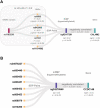This is a preprint.
A Higher Dysregulation Burden of Brain DNA Methylation in Female Patients Implicated in the Sex Bias of Schizophrenia
- PMID: 36778507
- PMCID: PMC9915764
- DOI: 10.21203/rs.3.rs-2496133/v1
A Higher Dysregulation Burden of Brain DNA Methylation in Female Patients Implicated in the Sex Bias of Schizophrenia
Update in
-
A higher dysregulation burden of brain DNA methylation in female patients implicated in the sex bias of Schizophrenia.Mol Psychiatry. 2023 Nov;28(11):4842-4852. doi: 10.1038/s41380-023-02243-4. Epub 2023 Sep 11. Mol Psychiatry. 2023. PMID: 37696874 Free PMC article.
Abstract
Sex differences are pervasive in schizophrenia (SCZ), but the extent and magnitude of DNA methylation (DNAm) changes underlying these differences remain uncharacterized. In this study, sex-stratified differential DNAm analysis was performed in postmortem brain samples from 117 SCZ and 137 controls, partitioned into discovery and replication datasets. Three differentially methylated positions (DMPs) were identified (adj. p < 0.05) in females and 29 DMPs in males without overlap between them. Over 81% of these sex-stratified DMPs were directionally consistent between sexes but with different effect sizes. Down-sampling analysis revealed more DMPs in females than in males when the sample sizes matched. Females had higher DNAm levels in healthy individuals and larger magnitude of DNAm changes in patients than males. Despite similar proportions of female-related DMPs (fDMPs, 8%) being under genetic control compared with males (10%), significant enrichment of DMP-related SNPs in signals of genome-wide association studies was identified only in fDMPs. One DMP in each sex connected the SNPs and gene expression of CALHM1 in females and CCDC149 in males. PPI subnetworks revealed that both female- and male-related differential DNAm interacted with synapse-related dysregulation. Immune-related pathways were unique for females and neuron-related pathways were associated with males. This study reveals remarkable quantitative differences in DNAm-related sexual dimorphism in SCZ and that females have a higher dysregulation burden of SCZ-associated DNAm than males.
Conflict of interest statement
Competing interests
All the authors declare that they have no conflict of interests.
Figures





Similar articles
-
A higher dysregulation burden of brain DNA methylation in female patients implicated in the sex bias of Schizophrenia.Mol Psychiatry. 2023 Nov;28(11):4842-4852. doi: 10.1038/s41380-023-02243-4. Epub 2023 Sep 11. Mol Psychiatry. 2023. PMID: 37696874 Free PMC article.
-
Attenuated sex-related DNA methylation differences in cancer highlight the magnitude bias mediating existing disparities.Biol Sex Differ. 2024 Dec 23;15(1):106. doi: 10.1186/s13293-024-00682-4. Biol Sex Differ. 2024. PMID: 39716176 Free PMC article.
-
Sex differences in DNA methylation across gestation: a large scale, cross-cohort, multi-tissue analysis.Cell Mol Life Sci. 2024 Apr 10;81(1):177. doi: 10.1007/s00018-024-05208-0. Cell Mol Life Sci. 2024. PMID: 38600394 Free PMC article.
-
Associations between infant sex and DNA methylation across umbilical cord blood, artery, and placenta samples.Epigenetics. 2022 Oct;17(10):1080-1097. doi: 10.1080/15592294.2021.1985300. Epub 2021 Oct 22. Epigenetics. 2022. PMID: 34569420 Free PMC article.
-
Drug Response-Related DNA Methylation Changes in Schizophrenia, Bipolar Disorder, and Major Depressive Disorder.Front Neurosci. 2021 May 13;15:674273. doi: 10.3389/fnins.2021.674273. eCollection 2021. Front Neurosci. 2021. PMID: 34054421 Free PMC article. Review.
References
-
- Castle DJ, Murray RM. The neurodevelopmental basis of sex differences in schizophrenia. Psychol Med 1991; 21(3): 565–575. - PubMed
-
- Leung A, Chue P. Sex differences in schizophrenia, a review of the literature. Acta Psychiatr Scand Suppl 2000; 401: 3–38. - PubMed
-
- Abel KM, Drake R, Goldstein JM. Sex differences in schizophrenia. Int Rev Psychiatry 2010; 22(5): 417–428. - PubMed
-
- Aleman A, Kahn RS, Selten JP. Sex differences in the risk of schizophrenia: evidence from meta-analysis. Arch Gen Psychiatry 2003; 60(6): 565–571. - PubMed
Publication types
Grants and funding
LinkOut - more resources
Full Text Sources

